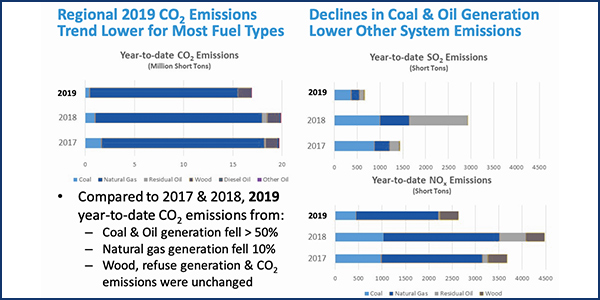ISO-NE is incorporating stakeholder comments and questions from December’s Planning Advisory Committee meeting as it works to complete its 2019 Economic Study in stages this year, the PAC heard last week.
The New England States Committee on Electricity (NESCOE), Anbaric Development Partners and RENEW Northeast submitted requests at the April 2019 PAC meeting for additional studies, which Patrick Boughan, ISO-NE senior engineer for system planning, said the RTO hopes to complete and publish in June and July.
“At previous PAC meetings, stakeholders requested us to evaluate other offshore wind interconnection points, but we’re only going to evaluate the interconnection points we previously presented,” Boughan said. “I think that we’ve provided a variety of interconnection points here at different points throughout the system, in Boston, off of the cape and off of Connecticut.”
“At what point does the addition of offshore wind start to cause large onshore transmission upgrade costs?” asked Theodore Paradise, Anbaric’s senior vice president for transmission strategy.
He said the region has spent about $14 billion on transmission upgrades (ISO-NE has cited $10.6 billion since 2002), creating a robust transmission system. “So, for example, west of Millstone [Nuclear Power Station in Connecticut], which is not being used in the study, has a lot of great injection points that can take 1,200 MW or more into uncongested parts of the system.
“There’s a lot of transmission there that we’ve invested in that we could see some real benefits [from] if we chose a couple of interconnection points, even just along the Connecticut shore,” Paradise said.
ISO-NE Director of Market Development Carissa Sedlacek told Paradise that the RTO has “taken on a lot of work” in agreeing to do three economic studies.
“I think we should focus on getting the NESCOE study done and move onto the Anbaric and RENEW [studies],” Sedlacek said. “Based on the scope of work that we decided in August, we’re going to be in a good position in another two months that we’re going to be ready to request additional economic studies, so that maybe part of the 2020 Economic Study could look at those interconnection points.”
In response to another stakeholder query, Boughan said the behind-the-meter PV category in the economic studies includes resources that do not participate in the wholesale markets but are reflected in the capacity, energy, loads and transmission (CELT) load forecast. The utility-scale PV category includes resources that have cleared in the Forward Capacity Market, are settlement-only generators or otherwise participate in the wholesale markets, he said.
CO2 Emissions down, Environmental Sensitivity up
Last year saw CO2 emissions from coal and oil generation drop more than 50% compared with the previous two years, while those from gas-fired generation fell 10%, Patricio Silva, the RTO’s lead analyst, told the PAC.
The RTO’s Environmental Advisory Group assists the PAC and the Reliability and Power Supply Planning committees in evaluating the impact of environmental rules on the regional power system.
Thursday’s update included regional system trends; regional generation and emission trends; the estimated impact of carbon pricing on regional energy costs; performance statistics from the Regional Greenhouse Gas Initiative; a timeline for the region’s Transportation Climate Initiative; and a snapshot of Massachusetts’ Global Warming Solutions Act and its CO2 cap on power plants, Silva said.
While retirements within New England obviously impact the system, closures in the greater Northeast and beyond also have indirect effects that may affect the RGGI compliance costs of generators in the region, he said.
“Likewise, changes in unit availability and interconnections over time could also indirectly affect the environmental performance of the system as we’re seeing more impacts from carbon compliance costs and as other costs decline … such as nitrogen oxide allowance and sulphur dioxide allowance costs that decline in both price and significance,” Silva said.
With the May 2019 retirement of the 680-MW Pilgrim nuclear plant in Massachusetts, the 2014 retirement of the 620-MW Vermont Yankee plant and an equivalent amount of coal-fired generation retired in that period, “the system is now sensitive, more than ever from an environmental performance standpoint, to changes in the weather and economic conditions,” he said.
– Michael Kuser




